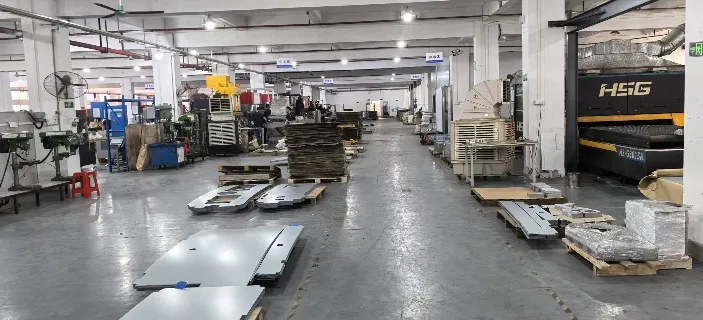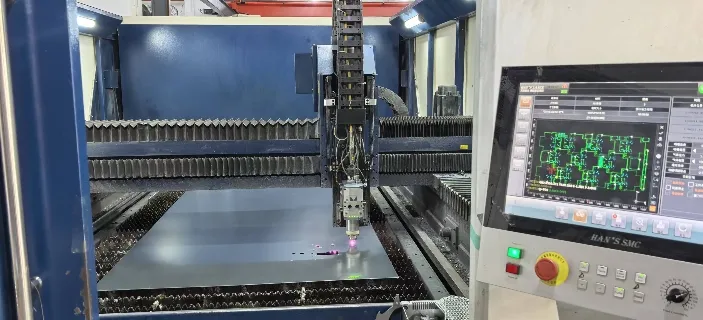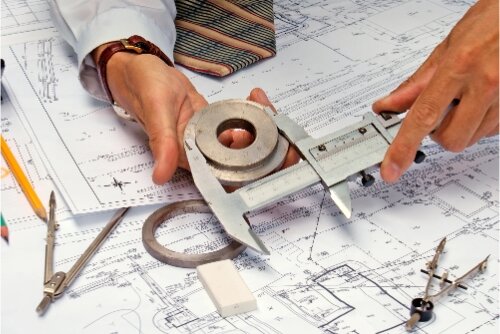Viele Fachleute verwenden die Begriffe "Fertigung" und "Herstellung", ohne sich bewusst zu sein, dass sie unterschiedliche Bedeutungen haben. Das kann sie verwirren, vor allem bei der Auswahl von Lieferanten oder der Planung der Produktion. Wenn die Begriffe nicht unklar sind, ist es leicht, das falsche Verfahren auszuwählen, was zu einer Verschwendung von Zeit, Geld und Mühe führt. In diesem Beitrag werden die Unterschiede in einfachen Worten erläutert, damit Sie bessere Entscheidungen treffen und Probleme vermeiden können.
Unter Fertigung versteht man den Prozess der Herstellung von Teilen oder Strukturen aus Rohmaterialien durch Schneiden, Biegen und Schweißen. Die Fertigung ist der umfassendere Prozess der Umwandlung von Rohstoffen in Fertigwaren. Sie umfasst die Fertigung, aber auch die Montage, Bearbeitung, Verpackung und vieles mehr. Die Fertigung ist das gesamte System, und die Herstellung ist nur ein Schritt darin.
Fertigung und Produktion überschneiden sich oft. Aber sie sind nicht dasselbe. Schauen wir uns einmal genauer an, wie sie funktionieren und wo sie sich unterscheiden.

Was ist Fabrikation?
Fabrikation bedeutet die Herstellung von Teilen aus Rohstoffen. Dazu gehört das Schneiden, Biegen, Schweißen oder der Zusammenbau von Metall oder anderen Materialien. Das Wort kommt vom lateinischen fabricate, was "herstellen" bedeutet.
Die Fertigung ist Standard im Baugewerbe, in der Automobilindustrie, in der Luft- und Raumfahrt und in der metallverarbeitenden Industrie. Dabei werden kundenspezifische Teile, Werkzeuge oder Strukturen hergestellt, in der Regel aus Blechen, Rohren oder Stangen.
Was ist Fertigung?
Unter Fertigung versteht man den gesamten Prozess der Umwandlung von Rohstoffen in Fertigerzeugnisse. Er umfasst viele Schritte wie Bearbeitung, Gießen, Formen, Zusammenbau, Prüfung und Verpackung.
Die Fertigung wird in der Massenproduktion eingesetzt. In Fabriken werden Produkte in großem Maßstab hergestellt - von Elektronik und Maschinen bis hin zu Kleidung und Geräten.

Hauptunterschiede zwischen Fertigung und Produktion
Die Begriffe mögen ähnlich erscheinen, unterscheiden sich aber in Zweck, Umfang und Methoden. Schauen wir uns an, wie sie sich in Bezug auf mehrere Schlüsselfaktoren unterscheiden.
Umfang der Arbeiten
Die Fertigung konzentriert sich auf die Formgebung und Verbindung von Materialien zur Herstellung von Teilen oder Strukturen. Die Herstellung umfasst die gesamte Kette von den Rohstoffen bis zu den verpackten, marktreifen Produkten.
Betroffene Produkttypen
In der Fertigung werden in der Regel Bauteile, Rahmen oder Strukturen hergestellt, die Teil eines größeren Produkts sein können. In der Fertigung werden die Endprodukte hergestellt, z. B. Maschinen, Werkzeuge oder Konsumgüter.
Verwendete Materialien
Bei der Herstellung werden hauptsächlich Metalle, Kunststoffe und Verbundwerkstoffe verwendet. In der Fertigung werden diese verwendet, aber auch Textilien, Chemikalien, Glas und mehr.
Produktionsvolumen und Umfang
Die Fertigung umfasst häufig kleine oder mittlere Serien. Sie unterstützt das Prototyping oder kundenspezifische Aufträge. Bei der Fertigung handelt es sich in der Regel um Großserien, die in großen Mengen an Fließbändern hergestellt werden.
Grad der Anpassung
Die Herstellung ermöglicht mehr Flexibilität. Jedes Teil kann nach individuellen Vorgaben gefertigt werden. Die Fertigung zielt auf Einheitlichkeit ab, mit wiederholbaren Prozessen, die Konsistenz gewährleisten.
Grad der Automatisierung
Die Fertigung ist stärker automatisiert, wobei Robotersysteme und Maschinen synchron arbeiten. In der Fertigung werden zwar auch Maschinen eingesetzt, aber oft ist mehr manuelle Arbeit oder halbautomatische Werkzeuge erforderlich.
Zeitrahmen und Vorlaufzeit
Fertigungsaufträge können schnell erledigt werden, insbesondere bei Einzelstücken. Die Herstellung dauert aufgrund der Einrichtung, der Produktionsläufe und der Nachbearbeitungsschritte länger.
Kostenstruktur und Investitionen
Die Fertigung hat niedrigere Anfangskosten und ist daher ideal für Kleinserien oder Sonderanfertigungen. Die Fertigung erfordert mehr Kapital - für Ausrüstung, Arbeitskräfte und Prozesssteuerungssysteme.
Anforderungen an die Qualifikationen der Arbeitskräfte
Verarbeiter brauchen technische Fähigkeiten wie Schweißen, Biegen und das Lesen von Zeichnungen. Fertigungsteams brauchen Bediener, Ingenieure, Planer und Mitarbeiter der Qualitätskontrolle.
Involvierte Prozesse
Jedes Verfahren spielt eine Rolle bei der Umwandlung von Rohmaterial in etwas Nützliches. Im Folgenden wird erläutert, wie sich die Schritte zwischen Herstellung und Produktion unterscheiden.
Gemeinsame Herstellungsverfahren
Diese praktischen Techniken verwandeln Rohmaterialien in maßgeschneiderte Teile. Sehen wir uns die wichtigsten Methoden an, die die Fertigung ideal für spezielle Projekte machen.
Schneiden
Beim Schneiden wird das Rohmaterial in die gewünschte Form oder Größe geschnitten. Zu den Methoden gehören Laserschneiden, Wasserstrahlschneidenund Plasmaschneiden.
Schweißen
Schweißen verbindet zwei oder mehr Metallteile miteinander. Durch Schmelzen der Teile und ggf. Zugabe von Füllstoff entsteht eine starke Verbindung.
Biegen
Biegen formt flache Bleche oder Stangen zu Winkeln oder Kurven. Abkantpressen und Walzen werden in diesem Schritt häufig eingesetzt.
Zusammenbau
Die Herstellung umfasst Zusammenbau Einzelteile zu einem endgültigen Rahmen oder einer Struktur. Dabei können Schrauben, Nieten oder Schweißnähte verwendet werden.
Gemeinsame Herstellungsprozesse
Die Massenproduktion ist auf diese wiederholbaren Systeme angewiesen. Entdecken Sie, wie Hersteller Effizienz und Konsistenz in großem Maßstab erreichen.
Bearbeitung
Bei der maschinellen Bearbeitung wird Material aus einem massiven Block entfernt, um ihn zu formen. CNC-Fräsen und Drehen sind beliebte Beispiele.
Gießen
Gießen ist das Gießen oder Einspritzen von Material in eine Form, um Teile zu formen. Es wird oft mit Kunststoffen oder Gummi verwendet.
Besetzung
Besetzung gießt flüssiges Metall in Formen. Sobald das Metall abkühlt und aushärtet, ist die Form bereit für die Endbearbeitung.
Fließbandproduktion
Bei diesem Verfahren werden mehrere Komponenten in einer festen Reihenfolge zusammengefügt. Es ist für die wiederholbare Produktion hoher Stückzahlen mit minimalen Abweichungen konzipiert.

Werkzeuge und Ausrüstung
Jedes Verfahren ist auf unterschiedliche Werkzeuge angewiesen, um bestimmte Produktionsziele zu erreichen. Die Art der verwendeten Ausrüstung spiegelt häufig den Umfang, die Präzision und den Automatisierungsgrad der Arbeit wider.
Maschinenpark in Fabrikationsbetrieben
In Fertigungsbetrieben werden Werkzeuge für die Formgebung und Verbindung von Materialien eingesetzt. Zu den gängigen Maschinen gehören:
- Laserschneider für präzisen Blechzuschnitt
- Abkantpressen zum Biegen von Metall
- Schweißstationen zum Verbinden von Teilen
- Scheren und Sägen zum Trimmen oder Schneiden
- Niet- und Befestigungswerkzeuge für die Montage
Diese Maschinen eignen sich häufig für kleine Auflagen und sind für einen schnellen Wechsel zwischen den Aufträgen eingerichtet.
Maschinen in Produktionsstätten
Bei den Fertigungseinrichtungen liegt der Schwerpunkt auf Geschwindigkeit, Umfang und Wiederholbarkeit. Zur typischen Ausrüstung gehören:
- CNC-Maschinen für die Hochpräzisionsbearbeitung
- Spritzgießmaschinen für Kunststoffteile
- Druckgussmaschinen für Metallteile
- Förderbänder und Roboterarme für Montagelinien
- Automatisierte Verpackungssysteme
Diese Werkzeuge sind in der Regel Teil einer umfangreichen Produktionslinie, die für die Massenproduktion ausgelegt ist.
Die Wahl zwischen Fertigung und Produktion
Die richtige Wahl hängt von Ihren Projektzielen, dem Auftragsumfang und dem Zeitplan ab. Hier erfahren Sie, wann welche Methode am sinnvollsten ist.
Wann man sich für die Herstellung entscheidet?
Die Fabrikation bietet sich an, wenn Ihr Projekt Flexibilität erfordert. In solchen Situationen ist handwerkliches Können wichtiger als Massenproduktion.
Kundenspezifische Projekte und Einzelanfertigungen
Die Fertigung ist ideal für kundenspezifische Designs. Diese Methode bietet mehr Kontrolle und Flexibilität, wenn Sie ein Teil mit einzigartigen Spezifikationen oder einen einmaligen Prototyp benötigen.
Anforderungen an kleine Stückzahlen und hohe Präzision
Die Fertigung ist besser geeignet, wenn Qualität wichtiger ist als Quantität. Sie ermöglicht enge Toleranzen, detaillierte Arbeit und qualifizierte manuelle Eingriffe.
Wann man sich für die Fertigung entscheidet?
Die Fertigung dominiert, wenn Menge und Konsistenz am wichtigsten sind. Hier ist die Großserienproduktion am sinnvollsten.
Bedarf an Massenproduktion
Die Fertigung eignet sich für Aufträge mit hohen Stückzahlen. Sie ermöglicht wiederholbare Prozesse, die dasselbe Produkt wiederholt mit gleichbleibenden Ergebnissen herstellen.
Kosteneffiziente Ausgabe in großem Maßstab
Die Fertigung ist der richtige Weg, wenn Sie die Stückkosten senken und die Produktion schnell steigern wollen. Sie verteilt die Fixkosten auf viele Einheiten und spart so langfristig Geld.
Hybride Ansätze
Bei einigen Projekten werden sowohl die Fertigung als auch die Produktion genutzt. Diese Mischung trägt dazu bei, Flexibilität mit Volumen und Kosten in Einklang zu bringen.
Die Herstellung kann zum Beispiel verwendet werden, um kundenspezifische Halterungen oder Rahmen. Diese werden dann in eine Fertigungsstraße zur vollständigen Montage weitergeleitet. Dies ist in Branchen wie der Automobilindustrie oder der Luft- und Raumfahrt üblich, wo einige Teile eine besondere Handhabung erfordern, während andere Standardverfahren folgen.
Dieser Ansatz ermöglicht individuelle Arbeiten, ohne die gesamte Produktion zu verlangsamen. Außerdem hilft es den Unternehmen, sich schnell an veränderte Bedürfnisse oder Designaktualisierungen anzupassen.
Schlussfolgerung
Fertigung und Produktion dienen unterschiedlichen, aber sich ergänzenden Zwecken. Die Fertigung zeichnet sich durch kundenspezifische Projekte mit geringen Stückzahlen aus, die Präzision und Flexibilität erfordern, z. B. Prototypen, Architekturelemente oder spezielle Maschinenteile. Die Fertigung dominiert die Großserienproduktion von standardisierten Artikeln, bei denen Kosteneffizienz und Konsistenz am wichtigsten sind, wie z. B. bei Unterhaltungselektronik oder Automobilkomponenten.
Sind Sie bereit, Ihr Projekt zum Leben zu erwecken? Ganz gleich, ob Sie Präzisionsfertigung, Großserienfertigung oder eine Hybridlösung benötigen - wir haben das Richtige für Sie. Fordern Sie noch heute ein kostenloses Angebot anund lassen Sie uns Ihre Ideen in die Tat umsetzen!
FAQs
Ist die Fabrikation eine Art der Herstellung?
Ja. Die Fertigung ist ein Teil des gesamten Herstellungsprozesses. Sie konzentriert sich auf die Formgebung und Verbindung von Materialien zur Herstellung von Komponenten.
Kann ein Fertigungsbetrieb auch die Produktion übernehmen?
Einige schon. Viele Fertigungsbetriebe konzentrieren sich auf kundenspezifische Arbeiten, aber einige erweitern ihr Angebot um die komplette Produktmontage und Verpackung.
In welchen Branchen werden sowohl die Fertigung als auch die Produktion eingesetzt?
In Branchen wie der Luft- und Raumfahrt, der Automobilindustrie, dem Baugewerbe und der Industrieausrüstung wird häufig beides verwendet. Sie können Rahmen oder Teile herstellen und das Endprodukt fertigen und montieren.
Wie entscheiden Sie, welche Sie für Ihr Produkt verwenden wollen?
Das hängt von Ihren Bedürfnissen ab. Verwenden Sie die Fertigung für kundenspezifische, Kleinserien- oder Hochpräzisionsaufträge. Entscheiden Sie sich für die Fertigung, wenn Sie hohe Stückzahlen, eine gleichmäßige und kostenorientierte Produktion benötigen.
Hey, ich bin Kevin Lee

In den letzten 10 Jahren bin ich in verschiedene Formen der Blechbearbeitung eingetaucht und teile hier coole Erkenntnisse aus meinen Erfahrungen in verschiedenen Werkstätten.
Kontakt aufnehmen

Kevin Lee
Ich verfüge über mehr als zehn Jahre Berufserfahrung in der Blechverarbeitung und bin auf Laserschneiden, Biegen, Schweißen und Oberflächenbehandlungstechniken spezialisiert. Als Technischer Direktor bei Shengen bin ich bestrebt, komplexe Fertigungsherausforderungen zu lösen und Innovation und Qualität in jedem Projekt voranzutreiben.




